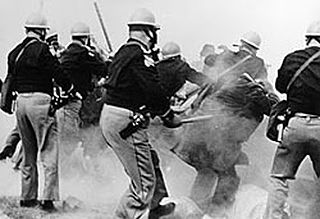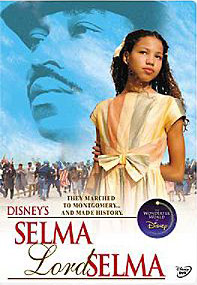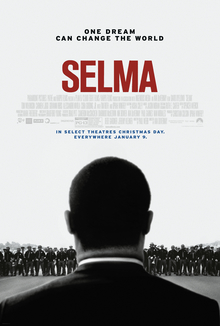
Selma is a city in and the county seat of Dallas County, in the Black Belt region of south central Alabama and extending to the west. Located on the banks of the Alabama River, the city has a population of 17,971 as of the 2020 census. About 80% of the population is African-American.

The Selma to Montgomery marches were three protest marches, held in 1965, along the 54-mile (87 km) highway from Selma, Alabama, to the state capital of Montgomery. The marches were organized by nonviolent activists to demonstrate the desire of African-American citizens to exercise their constitutional right to vote, in defiance of segregationist repression; they were part of a broader voting rights movement underway in Selma and throughout the American South. By highlighting racial injustice, they contributed to passage that year of the Voting Rights Act, a landmark federal achievement of the civil rights movement.

Amelia Isadora Platts Boynton Robinson was an American activist who was a leader of the American Civil Rights Movement in Selma, Alabama, and a key figure in the 1965 Selma to Montgomery marches.

Viola Fauver Liuzzo was an American civil rights activist in Detroit, Michigan. She was known for going to Alabama in March 1965 to support the Selma to Montgomery march for voting rights. There she was shot and killed by three Ku Klux Klan members while driving activists between the cities and transportation.

James Joseph Reeb was an American Unitarian Universalist minister, pastor, and activist during the civil rights movement in Washington, D.C., and Boston, Massachusetts. While participating in the Selma to Montgomery marches actions in Selma, Alabama, in 1965, he was murdered by white segregationists and white supremacists, dying of head injuries in the hospital two days after being severely beaten. Three men were tried for Reeb's murder but were acquitted by an all-white jury. His murder remains officially unsolved.

James Gardner Clark, Jr. was the sheriff of Dallas County, Alabama, United States from 1955 to 1966. He was one of the officials responsible for the violent arrests of civil rights protestors during the Selma to Montgomery marches of 1965, and is remembered as a racist whose brutal tactics included using cattle prods against unarmed civil rights supporters.

James "Spider" Martin was an American photographer known for his work documenting the American Civil Rights Movement in 1965, specifically Bloody Sunday and other incidents from the Selma to Montgomery marches.

Jimmie Lee Jackson was an African American civil rights activist in Marion, Alabama, and a deacon in the Baptist church. On February 18, 1965, while unarmed and participating in a peaceful voting rights march in his city, he was beaten by troopers and fatally shot by an Alabama state trooper. Jackson died eight days later in the hospital.
J. L. Chestnut Jr. was an author, attorney, and a figure in the Civil Rights Movement. He was the first African-American attorney in Selma, Alabama, and the author of the 1991 autobiographical book, Black in Selma: The Uncommon Life of J.L. Chestnut, Jr., which chronicles the history of the Selma Voting Rights Movement, including the 1965 Selma to Montgomery marches and Bloody Sunday.

Selma, Lord, Selma is a 1999 American made-for-television biographical drama film based on true events that happened in March 1965, known as Bloody Sunday in Selma, Alabama. The film tells the story through the eyes of an 9-year-old African-American girl named Sheyann Webb. It was directed by Charles Burnett, one of the pioneers of African-American independent cinema. It premiered on ABC on January 17, 1999.
Marie Priscilla Martin Foster was a leader in the Civil Rights Movement in the U.S. during the 1960s. Her successful voter registration in Dallas County, Alabama fueled her to become an activist, and she began teaching adult classes to help people pass the required literacy tests. She was the Alabama foot soldier that convinced Martin Luther King Jr. to come to Selma, Alabama and helped organize the Selma to Montgomery marches in 1965. Her dedication gave her the moniker "The Mother of the Voting Rights Movement," which was shortened to Mother Foster.

The Edmund Pettus Bridge carries U.S. Route 80 Business across the Alabama River in Selma, Alabama. Built in 1940, it is named after Edmund Pettus, a former Confederate brigadier general, U.S. senator, and state-level leader of the Alabama Ku Klux Klan. The bridge is a steel through arch bridge with a central span of 250 feet (76 m). Nine large concrete arches support the bridge and roadway on the east side.
Albert J. Lingo was appointed in 1963 by Alabama Gov. George Wallace to head the Alabama Highway Patrol, which he led until 1965 during turbulent years marked by marches and demonstrations that characterized the Civil Rights Movement in the U.S. South.
JoAnne Bland is the co-founder and former director of the National Voting Rights Museum in Selma, Alabama. Bland was a highly active participant in the Civil Rights Movement from her earliest days, and was the youngest person to have been jailed during any civil rights demonstration during that period. Bland grew up in segregated Selma, Alabama, where she was not allowed to enter certain stores and was only allowed to go in the library and movie theater on days labeled "colored." As a result of growing up in segregation Bland lost her mother, who died in a "white" hospital waiting for a transfusion of "black blood." Her grandmother encouraged Bland and her sister to march and become a freedom fighter to fight for their freedom, even though her father disapproved due to his fear for their lives. Her father's objections did not stop Bland, who became active in the movement when she was eight years old. When she was eight years old, she attended a meeting with the Dallas County Voters League with her grandmother.

Selma is a 2014 American historical drama film directed by Ava DuVernay and written by Paul Webb. It is based on the 1965 Selma to Montgomery voting rights marches which were initiated and directed by James Bevel and led by Martin Luther King Jr., Hosea Williams, and John Lewis. The film stars actors David Oyelowo as King, Tom Wilkinson as President Lyndon B. Johnson, Tim Roth as George Wallace, Carmen Ejogo as Coretta Scott King, and Common as Bevel.

The National Voting Rights Museum and Institute, established in 1991 and opened in 1993, is an American museum in Selma, Alabama, which honors, chronicles, collects, archives, and displays the artifacts and testimony of the activists who participated in the events leading up to and including the 1965 Selma to Montgomery marches, and passage of the 1965 Voting Rights Act, as well as those who worked for the African-American Voting Rights and Women's Suffrage movements. As the museum describes in its mission statement, it recognizes other people, events, and actions which furthered America's Right to Vote since "the Founding Fathers first planted the seeds of democracy in 1776." The museum was founded by Faya Ora Rose Touré and Marie Foster.
The history of the 1954 to 1968 American civil rights movement has been depicted and documented in film, song, theater, television, and the visual arts. These presentations add to and maintain cultural awareness and understanding of the goals, tactics, and accomplishments of the people who organized and participated in this nonviolent movement.
Richie Jean Sherrod Jackson, was an American author, teacher, and civil rights activist.

Frederick Douglas Reese was an American civil rights activist, educator and minister from Selma, Alabama. Known as a member of Selma's "Courageous Eight", Reese was the president of the Dallas County Voters League (DCVL) when it invited the Southern Christian Leadership Conference and Martin Luther King Jr. to Selma to amplify the city's local voting rights campaign. This campaign eventually gave birth to the Selma to Montgomery marches, which later led to the passage of the Voting Rights Act.
This is a timeline of the civil rights movement in the United States, a nonviolent mid-20th century freedom movement to gain legal equality and the enforcement of constitutional rights for people of color. The goals of the movement included securing equal protection under the law, ending legally institutionalized racial discrimination, and gaining equal access to public facilities, education reform, fair housing, and the ability to vote.













